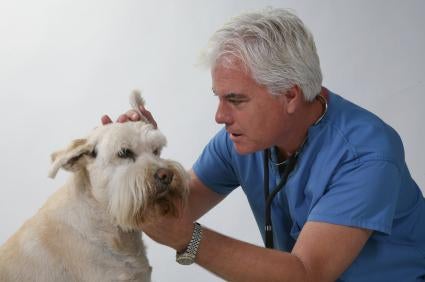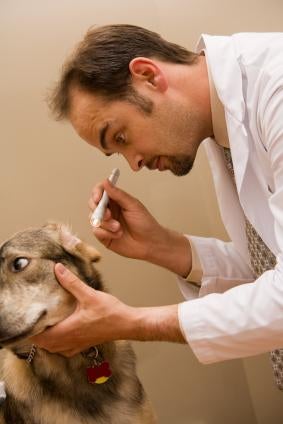Dog Ear Infections Symptoms & Treatment
Every dog has a natural level of bacteria and yeast growing in their ears. If this balance gets disturbed then an overgrown bacterial or yeast infection of the ears can occur. This overgrowth can cause a very intense irritation for your dog. Once you see the early signs that your dog is uncomfortable, then it is your duty to handle the situation appropriately - your dog is totally reliant on you.
Signs of Ear Infection In Dogs
If you notice any of the following symptoms, then your dog most likely has an ear infection.
- Discharge in the ears (often black and chunky, or yellow and pasty).
- Distinct pungent or chalky odor.
- Excessive scratching or rubbing of the ears.
- Redness or swelling in the inner flap and canal.
- Shaking or tilting head to the side.
- Pain to the touch of the ears.
- Irritable behavior.

Bacterial infections are mostly recognized by discharge, redness, swelling, or pain. Bacterial infections often have a pungent smell.
Yeast infections are known to cause discharge, redness, swelling, scaling, dryness, oozing and intense itching. Yeast ear infections smell chalky. They also spread to other parts of the body, such as the feet or face.
Other Possible Causes Of Ear Infection In Dogs
Before assuming your dog has an ear infection you should rule out the possibility of fleas, a trauma to the ear, tumors, ear mites, or foreign bodies.Fleas can be spotted crawling around your dog's belly or patch of hair just above the base of the tail. Flea combs will pull out any living fleas and flea dirt. If you find dark specs of grain in your comb, that is most likely eggs or feces left from fleas. Buy some over the counter flea medicine at your local vet office.
If your dog experienced a recent trauma, or blow to the head and is acting uncomfortable and off balanced, then this is definitely a case for the vet. He could have a ruptured eardrum with fluids building in his canal, or a hematoma developing. The vet will be able to drain the hematoma and prescribe the right antibiotics and anti-nausea medication.
If you see or feel a swollen knot in your dog's ear it could be a tumor. There are several different kinds of common ear tumors: ceruminous gland adenoma, sebaceous gland tumor, and basal cell tumor. Only your vet can determine which one it is and how to effectively treat it.
Ear mites cause the canal to bleed and the dried blood will look like ground up coffee grains. Ear mites are highly contagious from pet to pet and are most regularly the result of contact with an infected animal (often a cat). Over the counter ear mite medicine is sold at any pet store.
The most common foreign body that vets see lodged in a dog's ear is a foxtail. A foxtail is similar to a burr because it is made of a cluster of grass. It has a large tip with mini barbs that face away from the tip. The barbs hook and burrow into skin easily. More movement causes the foxtail to travel deeper into the tissue. Since foxtails have been known to travel through the rubber sole of shoes, then imagine the damage it can do to the soft tissue of your dog's ear. If you find a foxtail that is too far lodged for tweezers to remove, then see your vet.
How Do Dogs Get Ear Infections?
Consider your dogs environment. Does he spend a lot of time swimming or in moist air conditions? The excess water to his ears will throw off the balance of his natural bacteria and yeast growth. Right before bathing your dog, or taking him to the beach, you should rinse his ears with Epi-Otic flush. You can buy it over-the-counter at any Vet. Dogs have L-shaped ear canals that extend deeper than our vision can see. Fill his ears with the flush. He will shake his head, which will knock any debris loose. Cotton swab the inner flaps to rid the excess debris. Squeegee the canal in a pinching motion under the base of his ear on the outside of his skin. You will hear a squishing noise as it fills the canal. The flush is made with an ingredient that will dry out your dog's ears faster and more effectively than water can.
The inflammation could be a result of your dog having allergies. People with allergies tend to sniffle a lot and have watery eyes. Dogs get ear infections and swollen tissue around the pads on their feet. If the ear infections are reoccurring in your pet, then you should definitely consider this as a possibility. There are three types of allergies your dog could have: food, environmental, or flea allergies. Your vet can put you on a series of trials to determine the cause, or you could just get a VARL blood test done which will pinpoint the exact causes.
If your dog has a hormonal abnormality, such as hypothyroidism, then you can medicate him for this problem and control the ear infections. Hypothyroidism happens when his thyroid gland has an insufficient production of the thyroid hormone. Dogs with hypothyroidism tend to be much more fatigued, depressed, retain excess water, and are overweight with a strong inability to lose weight. A simple T-4 blood test at the vet will determine if this is the cause and give the vet the information needed to prescribe the right dose of Soloxine to control the issue.
A hereditary issue, or immune condition is also a possible cause of ear infections. Dogs prone to immune problems are stereotypically purebred's from a novelty breed - but not always. If your pup was born with a genetic disposition to having a weak immune system then you need to really monitor the nutrients in his diet and be on top of any health issues that can set him back. You can try natural supplements that will work as immune boosters in his diet.
How To Treat Dog Ear Infections
If you take your dog to the vet they will use an otoscope to look down his ear canal to determine the amount of inflammation he/she is dealing with. A cotton swab will pull out a sample of the overgrowth. The material will then be wiped onto a slide, stained, and looked at under a microscope. This procedure will help to identify whether it is a bacterial or yeast infection.For a bacterial ear infection the vet will provide you with Epi-Otic flush, Otomax ear drops, Cephalexin antibiotic and possibly Temeral-P which is a steroid.
For a yeast infection of the ears the vet will give you Epi-Otic flush, Mometamax ear drops or possibly Temeral-P.

If you are more holistically inclined and your dog has a yeast infection in his ears, you can try white vinegar - a common home remedy for treating dog ear infections. Use heavily diluted vinegar to remove the debris from his ears and to restore the natural balance. Fill his canal and allow it to soak. Massage the base of his ears to ensure total immersion. Wipe out any excess liquid with a cotton swab. Repeat this a few times a week.
To prevent both types of infections you should always keep your dog clean, exercised, maintain a healthy diet, and dry out his ears as much as possible after being exposed to water. Vitamin C is a great compliment to his diet because it is a proven antioxidant that will help fend off infections and regulate yeast. Herbs such as acidophilus and pau d'orca when used in conjunction with each other will inhibit the overgrowth of yeast and destroy the fungus contained in bacteria.
Good luck when treating your dog and remember it is always better to be safe rather than sorry when it comes to the health and wellbeing of your precious dog.
You may also be interested in my Dog Health Care article.
Please consult the services of a Professional Dog Trainer, Behaviorist or Veterinarian before implementing any of the advice contained on this site.










 Your Privacy Choices
Your Privacy Choices